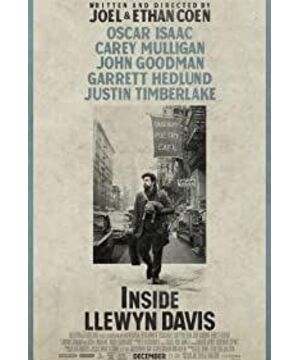"The Ballad of Drunken Township" tells the story of the protagonist, LeVine, who for many years watched his father only in pursuit of material satisfaction and no spiritual pursuit, so he gave up his stable sailor job and resolutely took his guitar and bravely To be a good "folk singer" dream. However, a dream is a dream after all, and the "folk singer" dream of Le Vern was still torn apart by the cruel reality. The scene at the end of the film where Reeves plays guitar and sings at the Gaslight Cafe can't help but feel endlessly sad and pathetic. The ideal is very plump and the reality is very skinny. Le Vern's reality is heavily shackled. He keeps running to realize that distant dream, but is still caught by life's wagging tail.
The film is carefully created in terms of play, so that LeVern encounters many strange people and things on the way to pursue his dreams, and tells him side by side: You are dreaming. On the way to Chicago, the protagonist LeVine met two strange people, an old fat man on crutches and his assistant who liked to smoke. As a result, when he was about to get to Chicago, the old fat man had a stroke in the toilet, and the assistant was just because he was in the bathroom. Parking on the road was taken away by the police. The tragic fate of these two characters also foreshadows the tragic fate of Levi's, and their fate also makes fun of Levi's dream, which is so ridiculous, so rambling, so absurd. Another example is the card that LeVern's nephew gave LeVern after he failed to pursue his dream and returned home, welcoming his uncle home. It means to welcome him back to the real society. The door of the real society is always open to unrealistic people, because after staying for a while, Le Vern has to worry about how he can survive normally and has to make money. He must feed himself before he can feed the dream, otherwise the dream is just a cloud that will eventually be swallowed by the sky.
The use of camera lenses in the film is very skillful, and a large number of push shots intensify the contradiction between the protagonist's inner longing and reality. When the three of Gene sang on stage, the camera gradually zoomed in on Gene in orange, and interspersed with the side shot of LeVine. For Le Verne, looking at Gene on the stage affectionately, it is outlined with a side shot, implying the distance between Le Verne and Gene, even if there is a child between them, even if Le Verne loves Gene deeply, they are not destined to be able to Go in the same direction. Another example is Levine, wearing a single leather shoe and a jacket, who was just driven out by the train attendant, standing on a snowy street, countless vehicles whizzing past him, and the cold wind blows his curly hair. The medium shot is pushed to a close-up of LeVine's face, and the white background color is all bleak. It vividly depicts the image of a down-and-out artist who is addicted to the spiritual world. It is also in the process of chasing dreams that the constant occurrence of such phenomena forces him to give up his dreams and force him to return to reality.
The reality is where we are, just like the professor's cat has been kept at home, but occasionally wants to break through that door, to venture into the outside world, to pursue dreams by faith, but in the end, the professor's cat returns by itself In the house, the dream will eventually wake up.
View more about Inside Llewyn Davis reviews











